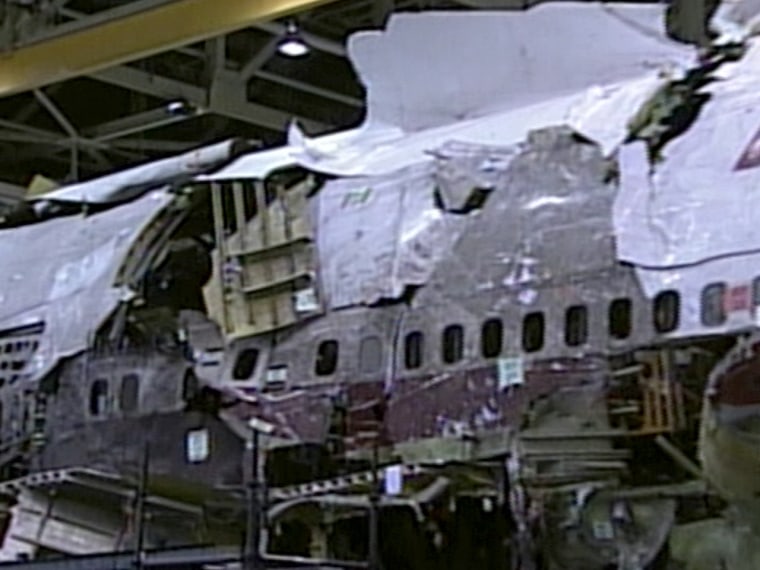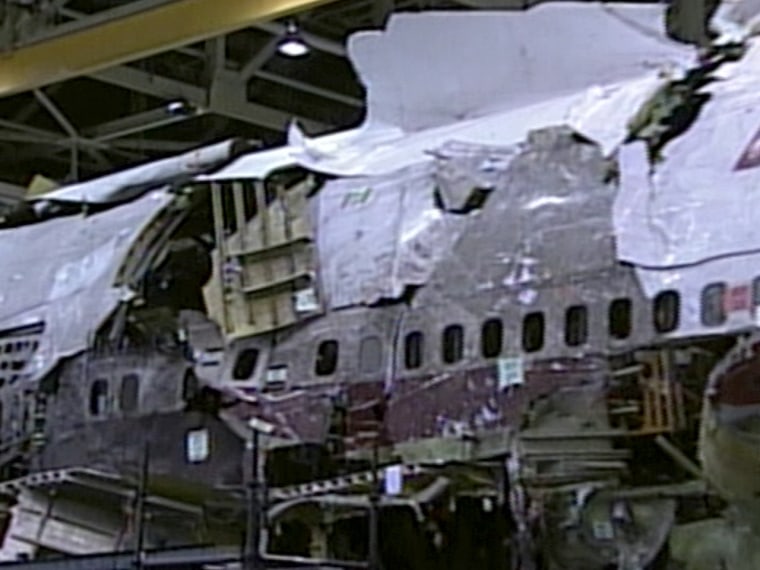
A new documentary featuring former investigators from several organizations is calling for the National Transportation Safety Board to reopen the investigation into why TWA Flight 800 exploded into a fireball off the coast of Long Island, N.Y., in 1996.
On July 17, 1996, the flight bound from New York’s John F. Kennedy Airport to Paris exploded 12 miles out into the Atlantic Ocean, killing all 230 passengers. The new film, titled “Flight 800,’’ features investigators from the NTSB, TWA and Air Line Pilots Association claiming the government ignored or covered up witness accounts and radar evidence of a missile hitting the plane. Eyewitnesses at the time reported seeing a streak that looked like a missile hitting the plane and causing it to explode.
A four-year, $40 million investigation by the NTSB, in which the wreckage of the plane was reassembled in a hangar, concluded that an electrical short circuit ignited a spark in the central fuel tank that caused the plane to explode.
Watch: Former FBI investigator says Flight 800 theories not true
Tom Stalcup, the director of the documentary, and James Kallstrom, the former assistant director of the FBI who investigated Flight 800, spoke with Savannah Guthrie on TODAY Thursday.
“It may not (look like a cover-up) at first glance, but if you look at the details, it really does,’’ Stalcup said. “The radar evidence confirms their (eyewitness) accounts of a streak moving toward the aircraft. Consistent with the trajectory of that streak is a detonation that exploded out the right side of the aircraft. Not only does that confirm their accounts, it refutes the NTSB’s theory.”
“Nothing he just said is true,’’ Kallstrom countered. “That’s my reaction. We had a massive investigation. We spent a year-and-a-half with a thousand FBI agents, experts from the military on missiles. We took the missile theory extremely serious. We interviewed all the eyewitnesses, some numerous times, because we knew in the FBI that there were shoulder-fired missiles available, that they were stolen from armories, that they were left on battlefields in Afghanistan and other places. We did a massive investigation of all military assets in the area. It just didn’t happen.”
One of the men disputing the results of the official investigation in the film is Hank Hughes, a former senior NTSB investigator. He is one of six investigators in the documentary claiming that it was not an explosion in the fuel tank that caused the plane to break apart.
“I believe that TWA 800 exploded as a result of an explosion exterior to the outside of the aircraft,’’ he told TODAY. “There’s no physical evidence to support that the center fuel tank exploded.”
Tom Haueter, a former chief NTSB investigator, stands by the findings of the exhaustive investigation.
“There is no evidence of anything from the outside penetrating through the tank,’’ he said. “No evidence of a bomb inside the fuselage itself, and just looking at all the wreckage you don't see any evidence of a missile impact or a missile detonating at close range."
Eyewitness sightings of a streak going toward the plane that looked like a missile could have been an optical illusion, according to Kallstrom.
“I account for it that they certainly saw something,’’ Kallstrom said. “The vast majority of the witnesses when we interviewed them heard the bang and looked up into the sky and it’s simple physics that they heard an event that happened somewhere between 30 seconds and 55 seconds before they heard the bang (because of) the speed of sound, the speed of light.
“So they were looking at a plane in distress that was breaking apart, and probably climbing 3,000 feet so they saw things going up, they saw things coming off. Plus, I don’t mean to degrade the witnesses, they reported what they saw and they’re good Americans, and we appreciate their participation, but eyewitness testimony is traditionally not very accurate.”
If there was some sort of cover-up by multiple agencies of a terrorist attack, the question remains of what motive there would be to do such a thing.
“That’s a very good question,’’ Stalcup said. “I’m just not going to answer that. What we really want to do is to reopen the investigation to get these questions answered because I know that’s on the public’s mind right now. We have evidence of that cover-up. The motive causes me to speculate. I can give ideas of what I think they were thinking at the time, but I can’t get inside the head of James Kallstrom.”
“We always said at the closing press conference that we’re 99 percent sure that this was not an act of terror,’’ Kallstrom said. “We have to prove a negative, and NTSB’s conclusion of the center fuel tank exploding is their summary of the investigation. The plane is still in a hangar in Virginia, so if they have this magical evidence, we can certainly look at that.”
The majority of the investigators in the film also waited 17 years to come forward, raising the question of why they waited so long to allege that the findings of the NTSB investigation are wrong or that it could have been terrorists attacking an American target.
“It’s not easy being a whistleblower in this country,’’ Stalcup said. “Some of these whistleblowers don’t get a fair shake.”
